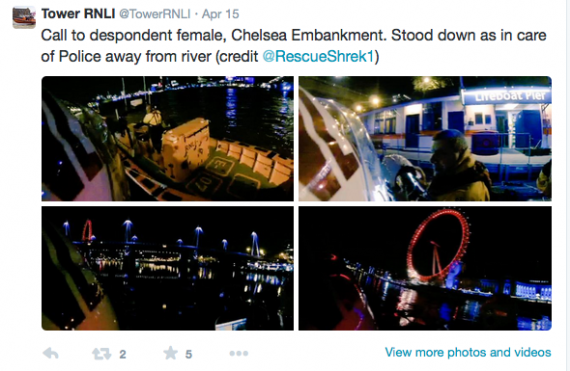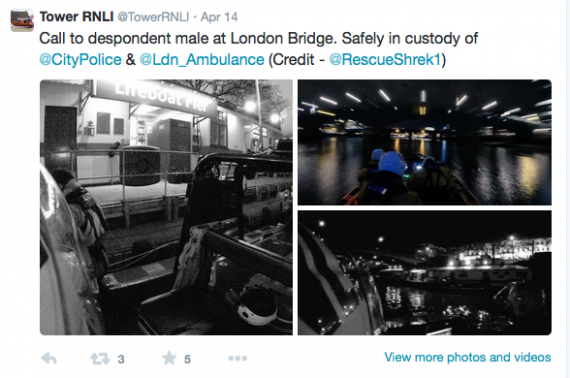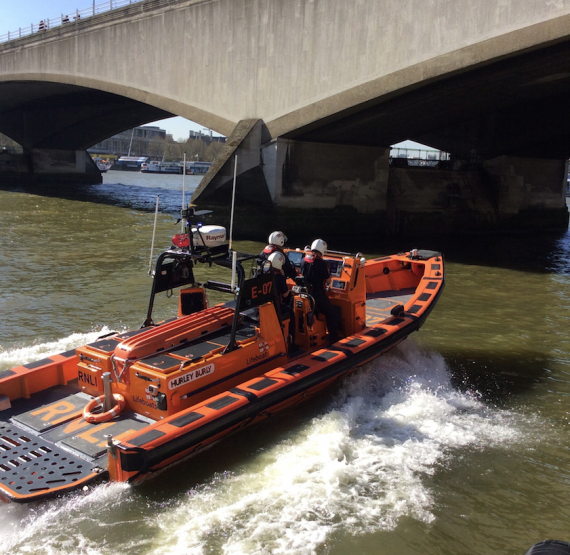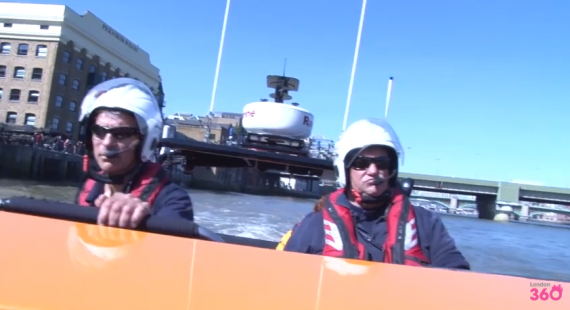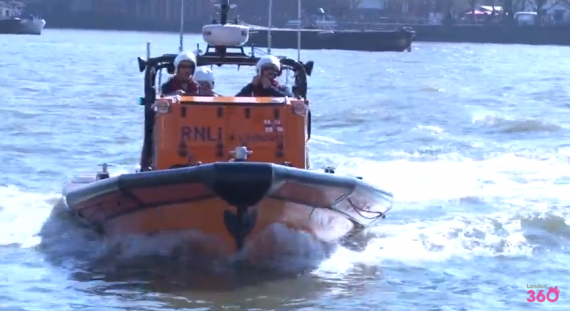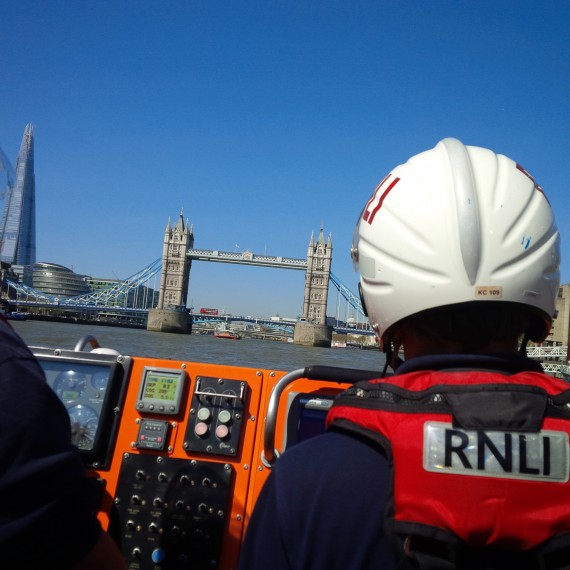The Royal National Lifeboat Institution – the charity that saves lives at sea…and in London!
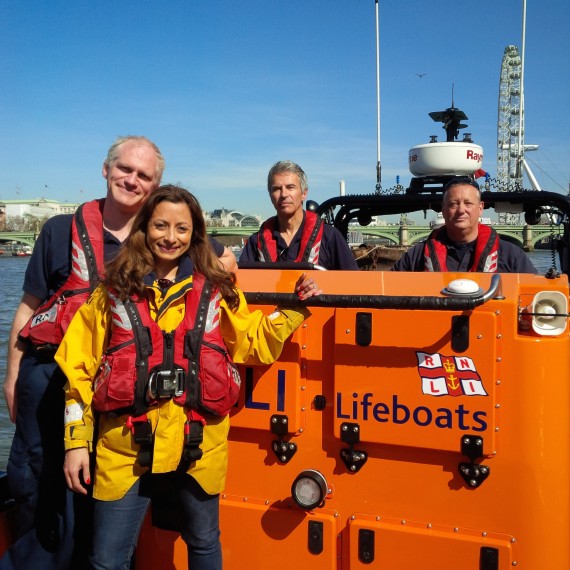
JASMINE WITH THE TOWER RNLI TEAM- GILES, KEITH AND STAN.
Most born and bred Londoners think we know all about what our great city has to offer, but even decades into the game I’m still fascinated by pockets of our community that I know nothing about.
This week I was invited to spend the day with the Royal National Lifeboat Institution station based at Embankment, (but called TowerRNLI , as that was their initial base years ago). In terms of history, the RNLI started in 1824, with small with privately set up lifeboats, which over the years grew bigger.
The TowerRNLI were formed in 2001,in response to the inquiry into the collision between the pleasure cruiser Marchioness and the dredger Bowbelle in August 1989, which claimed the lives of 51 people. 64 year old Staff Helmsman Keith Cima welcomed us into a kit room full of safety uniforms and yellow willies and told me
‘’a lot of young people lost their lives that night. There were a number of enquiry’s after that disaster and one of them was about safety on the Thames and the RNLI were then asked to provide cover on the river. We are specialists in search and rescue. We cover 16 miles of the Thames from Battersea Railway Bridge to Woolwich but most action happens here in central London’’.
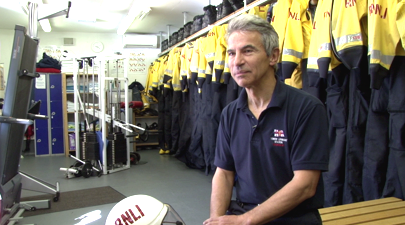
THE BOSS – HELSMAN KEITH CIMA.
(Yellow wellies are an essential piece of RNLI crew kit – they give crew members protection, warmth and, importantly, grip when they’re out in rough seas so Yellow wellies have become an iconic symbol for the lifesaving charity)
If you think London’s roads are busy then spare a thought for the waterways. The Thames is like a daily floating carnival. Staff Helmsman Keith welcomes us into their kit room and explains ‘’ It’s a very busy river in a capital city of 8 million people, but its also a community in its own right. Apart from us there are the marine police who we work very closely with, the fireboats and crews, the watermen, the tugs and cargo ships that deliver sand and aggregate for the new buildings being built and of course there is the commercial passenger traffic. There’s a commuter service on the Thames, which carries hundreds of thousands of passengers a day between Woolwich and Putney, like a bus service on the river. There are also thousands of boats full of tourists, let alone private boat owners and lots of canal boat users. On a busy summers afternoon that water out there is packed with all sorts of boats, all obeying the rules of the river road. Many of us all know each other, the marine police and passenger boat drivers. Whenever there’s a problem on the river everybody mucks in. Sometimes a passenger boat will see something and call us on the radio, and point the bow of their boat towards the danger. We are a community in London in our own right.’’
I follow @TowerRNLI on twitter, and am constantly fascinated with the incredible photos and stories about our river at all hours and how crazily busy they are. I’m also impressed by the fact that they’re even on twitter! Keith laughs ‘’over the last decade social media has become a great way of reaching everyone, so to us social media, community websites and TV stations are really important to let us know what’s happening on this river and at the RNLI.’’
In that horrid way that we like to follow morbid news, I am always glued to their twitter feed when I read that someone ‘’has entered the water’’. Keith explains the many reasons…’’This station tower lifeboat last year was called about 543 times and over half of these call outs refer to people entering the river for one reason or another. Accidently falling in, devilment – doing it for a dare, perhaps drink and drugs and despair are a factor. Not all go into the river. We assistant many whilst they’re still on shore and we assist and talk them down safely. There are all sorts of people that are affected by this, it can be anybody, its not confined to one particular group in society.’’
Keith also explains that drunken partying isn’t limited to nightclubs on land ‘’ If you’re with a group of lads, drinking or behaving wildly look out for each other. The party boats are always fun late at night when something’s kicked off. Often alcohol is to blame, and then it gets messy if they fall off. The remaining things are miscellaneous, boats breaking down, dogs needing to be rescued, if we don’t rescue dogs then their owners or members of the public will, and then that’s another job. In all of these 543 calls out, a very large proportion involve medical work, so we’re all trained in medical work. Our staff can see horrific things that they didn’t expect to see. That can have an affect on all our staff, so we ensure that our crew are ok afterwards. The RNLI has a very good 24-hour support helpline’’.
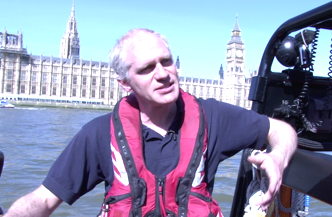
TOWER RNLI VOLUNTEER GILES HARRISON.
Volunteer Giles Harrison shakes his head ‘’One of my most memorable shouts was a few weeks ago on Valentines evening on one of the restaurant boats, they had a man that had collapsed. A German man and his girl friend had come over for a romantic evening out, he’d prosed to her and given her a ring, they toasted with a glass of champagne and then he collapsed with a severe allergic reaction to champagne. We took care of him and then passed him over to the ambulance service, so that’s an engagement story he’s not going to forget!’’
There are 237 RNLI lifeboat stations around the UK and Ireland. Their operation relies on 4,800 dedicated lifeboat crewmembers – 95% of whom are volunteers. There are three London lifeboat stations, on the River Thames; Chiswick, Teddington and Tower. Most of the RNLI’s lifeboats at its 237 stations around the UK and Ireland, are operated by volunteers, but, at Tower and Chiswick, full-time lifeboat crews work 12-hour shifts to ensure this on-call commitment on the River Thames in the heart of the capital and they’re backed up by many volunteers. There are over 150 dedicated crewmembers on the Thames, ready to serve London 24 hours a day, every day.
Keith told me that volunteers come from all walks of life ‘’ In terms of lives saved on the Thames, 231 people were rescued by tower station, Chiswick and Teddington last year. This year so far we have already saved 7 lives. We have volunteers that are from all walks of life emergency services, lawyers, BBC film producers, environment agencies, academics, business, banking and more. We have lots of women too. There’s a waiting list for people to join this station. We have probationary periods where we work with new people. We train them in a very structured way, then after 18 months they go down to Poole where they do intensive training.’’
Lifeboat crew training
As only one in 10 RNLI volunteer lifeboat crew members has a professional maritime occupation, the RNLI provides rigorous training – most of which takes place at the charity’s specialist training facility, RNLI College.
The crews receive on going, specialist training, which ensures they can operate safely and effectively in the most difficult and dangerous conditions. In RNLI College’s sea survival pool, darkness, thunder, lightning, and helicopter recovery can all be simulated. In this facility, crews can learn vital survival techniques and go through capsize drills, so they know what to do should the worst happen while they are at sea on a rescue.
They undergo extensive RNLI training and must maintain a high level of fitness throughout the lifeguarding season – their fitness levels are tested monthly.
In 2014, RNLI lifeguards responded to 17,050 incidents, rescued 1,769 people and saved 92 lives.
The Tower station is a floating station so we had to shoot our TV interviews with RNLI crewmen with our newly found sea legs. The crew work in 4 days on/4 days off shifts, and have living quarters on site. RNLI lifeboat crewmembers are on-call 24/7, 365 days a year. Most have a full-time day job, but they carry a pager and, when it goes off, they rush to the lifeboat station and launch the lifeboat to rescue those in danger.

TOWER RNLI HELSMAN STAN TODD.
Helmsman Stan Todd told me ‘’I got involved with the RNLI 35 years ago after I left the army, I saw bangs up in the sky and saw the Brighton lifeboat launch. I was looking for a new commitment in my life and I joined the Brighton Lifeboat Station there and then. One of the great things about working here is that you never know what you’re going to next, it could be a fire, person in the water, helping a lost of disorientated person, we get a lot of swimmers who think it’s a good idea to get into the water after a couple of drinks, then they find out how cold the water is and cramp up and lose the ability to swim. A lot of our jobs are to stop kids getting into trouble that are playing on the foreshore and may become trapped by the incoming tide’’.
Flood Rescue
The RNLI flood rescue team is a group of volunteers specially trained in swift water rescue. They also travel in the UK and worldwide to help rescue people affected by flooding. In November 2009, RNLI flood rescue volunteers went to Cumbria to help the people whose homes were severely flooded after very heavy rain. Using nine inshore lifeboats specially transported to the area, they rescued around 300 people from the floodwaters.
With heavy rain in 2012, the RNLI’s Flood Rescue Team had its busiest year to date, with 12 deployments in areas including Teesside, Aberystwyth, Belfast, Bridgwater, and St Asaph. In 2013 / 14 the teams were also kept busy in Wales, North Devon, Berkshire and Somerset.
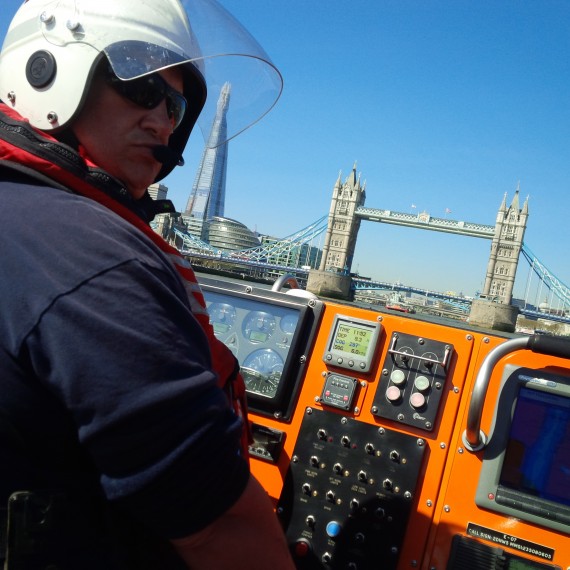
STAN TAKES US FOR A ‘SHOUT’ ON THE RIVER.
Keith confirms it’s risky business in the heart of London too…’’compared to a coastal station we have no big waves and winds, but the risk is transferring from a lifeboat to passenger boat or jump from boat to mooring post to rescue a drowning person clinging on, some people in the water are dangerous and volatile. Some of our casualties are violent and armed and there’s a risk, but the risks are outweighed by the enormous satisfaction of helping someone that’s hurt or badly distressed. To see someone who you’ve seen completely lifeless in the water, then resuscitate them and see them walk off the pier 30 minutes later is the most extraordinary privilege known to man and that’s the point of the job. That’s why our volunteers keep coming back.’’
RNLI volunteers have responded to the Mayday calls of those in distress for more than 190 years. In 2014 alone, the charity’s lifeboat crews launched the lifeboats 8,462 times, rescuing 8,727 people. That’s an average of 24 people every day! Apparently double the number of people die due to water related incidents than fire.
Keith talks through a typical day ‘’Firstly we’re afloat, we move up and down with the tide and it gets rough so it can knock you off your feet. Our shifts last 12 hours. We start at 6am and take over from the night shift and get a brief of what’s happened overnight. We start with safety checks on the boat, there’s always cleaning to be done. We usually get a visit from visitors, which is fine as only 39% know we exist. We have admin and paperwork and training and so go out on the water to practise anchoring, mooring and first aid, but we’re always awaiting the bell to go and then that’s the coastguard asking us to launch. The day is always busy and interrupted by the bell, which means someone is in the water and needs help .We have to launch within 90 seconds.’’
Keith keen to point out as the sun gets hotter and you feel a dip in the Thames would be a fun thing to brag about ‘’The message for Londoners is this is the best river running through any capital in the world, but it’s also a very dangerous and very capricious river with very big, very strong tides in it. It’s not a rover to go in, you may think you can swim 200 yards across the river, but you cant the river will always beat you so stay out of the river, if you’re drinking stay away. Many of our casualties are drunk people who overindulge and over balance and fall in. if you ever see anyone in trouble near any of London or the uk’s water dial 999 and ask for the coastguard’’.
Giles has the final word ‘’What I love about being a volunteer with the RNLI is it’s rewarding and exciting, we’re here to save lives at sea and prevent loss of life on the Thames. That’s what we’ve been doing for 124 years and its an honour to be a part of such an honourable tradition!’
This lifesaving charity relies on voluntary donations from the public for over 92% of its income. It costs them over £140 million each year to run our lifesaving service. It costs around £1,400 each year to train each of their 4,600 lifeboat crew and £500 to train, to RNLI standards, one lifeguard each season.
This May Day (April 28th), the RNLI is issuing its own call for help, appealing for the public to support its national fundraising campaign.
All the money raised will help the RNLI’s volunteers to continue to save lives at sea. Funds will go towards training and kitting out the charity’s 4,600 crewmembers and maintaining the charity’s 237 lifeboat stations.Fundraising kicks off with street collections in London on 28 April and, following that, collections and fundraising events are taking place throughout the UK and Ireland across the May Day bank holiday weekend.
Show your support by making a donation, buying and wearing a yellow welly pin badge and by taking to social media using the hashtag #YellowWelly.
To donate, visit RNLI.org/Mayday.
Text MAYDAY to 70007 to donate £3 #YellowWelly

 Follow
Follow